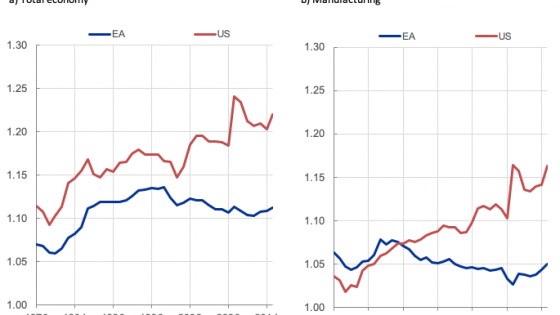If data is the new oil, will it spawn a new era, like the industrial age, with oil magnates and robber barons? Will those who own data create value and share that value with consumers? Without a doubt, data improves economic efficiency (Goldfarb and Tucker 2019). It lets firms make more informed decisions based on facts and analysis, rather than intuition and guesses. This allows firms to reduce uncertainty and forecast operations, from the preferences of their customers to their future costs (Bajari et al. 2019). Because data-abundant firms can operate more efficiently and with less uncertainty, they also naturally grow larger. We tend to think that if efficient firms grow, that’s as it should be. But if larger firms generate more data, which, in turn, fuels firm growth, market power becomes a serious concern.
For an economist, a natural reaction to this discussion would be to measure market power, particularly for firms known to harbour large troves of data. The most common way of doing this would be to estimate the firm’s markup – the price of its goods, divided by their marginal cost. Firms that have high markups are earning high profit margins. This is interpreted as a sign of market power.
In a recent paper (Eeckhout and Veldkamp 2022), we argue that firms’ data can reduce markups, even if it confers more market power. Data has competing effects on a firm’s product markup.
On the one hand, firms use data to operate more efficiently and reduce their marginal cost. They pass some, but not all of this cost savings on to customers, thus raising markups. This idea of cost-reducing investment as a source of market power is reminiscent of Sutton (1991, 2001). On the other hand, firms price risk. Data reduces risk, by allowing firms to forecast future profits more accurately. While risk pricing is an unusual feature in the competition literature, it has a long tradition in corporate finance. Almost every MBA student is taught to price risk, when making important decisions. When risk is priced, markups are, in part, a way for firms to earn a fair return for the risks they bear. Without such a return, no one would invest in this firm. When data improves forecasts and resolves uncertainty, it reduces risk, reduces the required return, and keeps markups low. The cost and risk channels have opposing effects. Whether data will increase or decrease markups depends on the firm’s marginal cost of investment and its price of risk.
The message here is not that markups and market power are just fine, because markups are a mere compensation for risk. The returns on many firms are far in excess of what a standard risk-return trade-off would warrant. Rather, the point is that data operate on the competition margin and on risk. The nature of information is to resolve uncertainty (i.e. reduce risk). Studying the data economy requires accounting for the effect of risk. This is not likely to be a small effect. Of the average return on equity, only about one-third is riskless return and two-thirds is compensation for risk. Accounting for the decline in risk, we may well find that the changes in market power are even more worrying than we previously thought.
The evidence about trends and cycles in markups have been the subject of some debate in the empirical literature. It turns out that if firms’ data stocks are growing, this can explain why different measures of markups show different trends and cycles.
The competing forces of data on market power depend on the level of aggregation at which markups are measured. Firms use data to skew production toward higher-markup goods, or to locate in a higher-profit area of the product space. Thus, data create a composition effect, which weighs high-markup goods more in the firm markup. The more a firm invests in data, the bigger the wedge between product-level markups and firm-level markups. A similar aggregate effect arises when we compare firm-level markups with industry-level markups. Thus, the divergence between product, firm, and industry markups does not mean one is right and the others wrong. Instead, this is a sign that firms are using data to reallocate production to the goods that are most profitable. Risk, and the growth of data, may therefore help us understand the evolution of markups since 1980.
Data can also explain the cyclicality of markups. Ramey and Nekarda (2020) have pointed out that while aggregate, sectoral markups are countercyclical (e.g. Bils 1987), firm-level markups are procyclical. If recessions are times of greater uncertainty, then data naturally gives rise to different cyclical patterns of firm and sector markups. This finding offers a variation on the interpretation of the mechanism in Burstein et al. (2020).
Like oil, data hold enormous potential to unlock efficiency gains. Data allow firms to lower their uncertainty and forecast better. But firms may also use data to create a dominant position. Back in the early 1900s, Standard Oil created a dominant position from massive investment in oil exploitation. Firms that heavily invest in data may be able to achieve the same. The first step to remedy market power is to fully understand how we measure it.
References
Bajari, P, V Chernozhukov, A Hortacsu and J Suzuki (2019), “The Impact of Big Data on Firm Performance: An Empirical Investigation", AEA Papers and Proceedings 109: 33-37.
Bils, M (1987), “The Cyclical Behavior of Marginal Cost and Price”, American Economic Review 77: 838–55.
Burstein, A, V Carvalho and B Grassi (2020), “Bottom-up markup fluctuations”, NBER Working Paper.
Covarrubias, M, G Gutierrez and T Philippon (2020), “From Good to Bad Concentration? US Industries over the past 30 years”, NBER Macroeconomics Annual 34: 1–46.
Cowgill, B, A Prat and T Valletti (2022), “Political power and market power: Evidence from mergers”, VoxEU.org, 16 May.
De Loecker, J, J Eeckhout and G Unger (2020), “The Rise of Market Power and the Macroeconomic Implications”, Quarterly Journal of Economics 135: 561–644.
Ederer, F and B Pellegrino (2022), “A Tale of Two Networks: Common Ownership and Product Market Rivalry”, NBER Working Paper.
Eeckhout, J and L Veldkamp (2022), “Data and Market Power”, NBER Working Paper.
Goldfarb, A and C Tucker (2019), “Digital Economics”, Journal of Economic Literature 57(1): 3-43.
Grullon, G, Y Larkin and R Michaely (2016), “Are US Industries Becoming More Concentrated?”, Working Paper.
Hall, R (2018), “New Evidence on the Markup of Prices over Marginal Costs and the Role of Mega-Firms in the US Economy”, NBER Working Paper.
Ramey, V and C Nekarda (2020), “The Cyclical Behavior of the Price-Cost Markup”, Journal of Money, Credit, and Banking 52: 319–53.
Sutton, J (1991), Sunk costs and market structure: Price competition, advertising, and the evolution of concentration, MIT press.
Sutton, J (2001), Technology and market structure: theory and history, MIT press.



